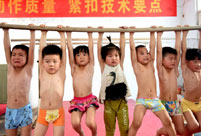 The 4th Chinese National Pole Dance Championship held in Tianjin
The 4th Chinese National Pole Dance Championship held in Tianjin
 Chinese navy commandos debut at 2014 RIMPAC
Chinese navy commandos debut at 2014 RIMPAC
 Guangxi impression: scenic countryside
Guangxi impression: scenic countryside
 World's largest aquatic insect found in Sichuan
World's largest aquatic insect found in Sichuan
 Ceremony volunteers for Youth Olympics make public appearance
Ceremony volunteers for Youth Olympics make public appearance
 A glimpse of female crew of Liaoning aircraft carrier
A glimpse of female crew of Liaoning aircraft carrier
 Stills from "Dad, where are we going?"
Stills from "Dad, where are we going?"
 Legless man's happy life
Legless man's happy life
 Top ten most beautiful islands in China
Top ten most beautiful islands in China
 Aerial view of Hong Kong
Aerial view of Hong Kong
"The glass-half-full view is that the imbalance has stopped getting worse. The half-empty view is that the difficult transition of weaning the economy off investment has not yet begun."
He does, however, believe there are some positive trends that suggest rebalancing is actually taking place.
"There has been a big slowdown in real estate construction. It might be giving people the jitters now but it is needed for the overheated construction sector to return to a sustainable path. Meanwhile, other parts of the service sector have continued to do well."
He, too, believes it is difficult to make firm judgments based on the last two quarters' data.
"If we look over the past four quarters, consumption and investment have contributed roughly the same to growth and this suggests both have now stabilized relative to GDP."
Jonathan Garner, chief Asia strategist of Morgan Stanley, based in Hong Kong, is confident China is achieving rebalancing and is now at the point Japan reached in the 1970s and South Korea in the 1980s.
"If you look at the economic history of both South Korea and Japan, China is about to reach the GDP per capita that they both reached when a consumer society took hold.
"At that point, most of the physical infrastructure has been done and the savings ratio begins to fall."
Garner, who presented his own research on China's rebalancing and reform agenda in Beijing last month, says much of the evidence of rebalancing is seen in consumption data. The number of passenger cars registered in the first five months of 2014, according to Morgan Stanley research, increased 15.5 percent over the same period last year, faster than items associated with investment spending, like cement consumption increasing 5 percent and that of steel just 3 percent.
"These are drawn from the official China statistics and it is a trend that has been running for three to four years and still has further to run," he says.
Louis Kuijs, chief China economist at the Royal Bank of Scotland, also says it is difficult to make solid assessments on the 2014 data to date.
"I think data relating to consumption, investment and exports can be pretty decent at an annual level but more problematic in making firm conclusions about it at a quarterly level," he says.
He is prepared to give the government some credit with its policy responses and actions.
"I think government policies like exchange rateappreciation have shifted the terms of trade in favor of the nontradable sector, which tends to favor the domestically oriented services sector," he says.
This was one of the factors that led services to increase as a proportion of GDP from 44.6 percent in 2012 to 46.1 percent last year, while the secondary sector declined over the same period from 45.3 to 43.9 percent.
"Some of the change can simply be explained by relative price changes, however. There has been downward pressure on factory gate prices over this period, which affects manufacturing but not services. So what you might be seeing also in the statistics is the price impact on the data and not volume effects."
Yifan Hu, managingdirector, chief economist and head of research at Haitong International, the Shanghai-based securities firm, says rebalancing the economy is a long haul.
At the start of the decade, the government set itself the goal of doubling China's per capita income by 2020.
 |
 Zhujiang ambassadors attend lotus lanterns activity
Zhujiang ambassadors attend lotus lanterns activity
 From girly girl to tough special police officer
From girly girl to tough special police officer
 Children attend gymnastics training in summer
Children attend gymnastics training in summer
 Beautiful sceneries along the special travel route in Xinjiang
Beautiful sceneries along the special travel route in Xinjiang
 Focus on 1st female patrol team in Turpan
Focus on 1st female patrol team in Turpan
 Collection of 'China Dream' public-spirited ads
Collection of 'China Dream' public-spirited ads  National fitness team members integrate traditional and modern beauty
National fitness team members integrate traditional and modern beauty Moms on their kid’s coming out
Moms on their kid’s coming out Chinese fighters through lens
Chinese fighters through lens
 48 hours after super Typhoon Rammasun
48 hours after super Typhoon Rammasun Bikini show held at water park in Xi'an
Bikini show held at water park in Xi'an
 Lobster vs cat: catch me if you can
Lobster vs cat: catch me if you can  Heat waves sweep China
Heat waves sweep China  Top 10 most beautiful islands in China
Top 10 most beautiful islands in China
 Zhou Xun announces engagement to Archie Gao
Zhou Xun announces engagement to Archie Gao
Day|Week|Month